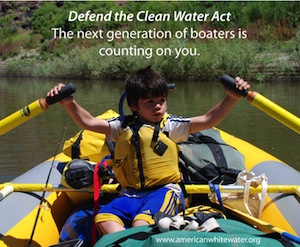 American Whitewater works to defend and strengthen water quality protections for our nation’s rivers and streams for the health and safety of all who recreate in and on them. Water quality directly impacts whitewater boaters as they get splashed, flip over, and occasionally swim. While all of this is part of the fun, it’s less so if the water that gets into paddler’s mouths, ears, noses, and any cuts is polluted. The issue of protecting water quality is also especially important to boaters because most whitewater rivers and streams can only be descended during higher than normal flows caused by rainfall or during snowmelt. Surface runoff and pollution often spike during these times.
American Whitewater works to defend and strengthen water quality protections for our nation’s rivers and streams for the health and safety of all who recreate in and on them. Water quality directly impacts whitewater boaters as they get splashed, flip over, and occasionally swim. While all of this is part of the fun, it’s less so if the water that gets into paddler’s mouths, ears, noses, and any cuts is polluted. The issue of protecting water quality is also especially important to boaters because most whitewater rivers and streams can only be descended during higher than normal flows caused by rainfall or during snowmelt. Surface runoff and pollution often spike during these times.
Good water quality is also important to rural communities that depend on recreation and tourism as the foundation for their economies, as well as businesses that are connected to watersports. A 2017 report by the Outdoor Industry Association found that annually, watersports directly generate:
- $139,971,810,172 in retail spending
- 1,234,876 jobs
- $43,893,049,709 in salaries and wages
- $10,618,742,884 in federal taxes
- $9,601,521,150 in state and local taxes
Since the passage and implementation of the Clean Water Act in 1972, our nation’s rivers have recovered in a remarkable way. However, we’re far from meeting the Act’s goal of making all of our waterways fishable, swimmable and drinkable. Our rivers often flow through a tenuous balance between pollution discharges and public and riparian health. Many rivers and streams are far from thriving, and are very near critical thresholds for public health and ecological function.
Historically, the Clean Water Act protected our nation's headwater streams and wetlands from pollution. Two Supreme Court cases in 2001 and 2006 created uncertainty about which streams and wetlands the Clean Water Act protects. This uncertainty affects over 60% of streams and millions of acres of wetlands across the country. Not only are these the streams that we boat on (and swim in), but this is where 1 in 3 Americans get their drinking water. In 2015, the Environmental Protection Agency reviewed and synthesized the scientific information about the connectivity of these headwater streams and wetlands to downstream waters. Read the EPA's report here: "Connectivity of Streams and Wetlands to Downstream Waters: A Review and Synthesis of the Scientific Evidence";
American Whitewater has long supported clarifying protection for these headwater streams, creeks and wetlands because it means healthier rivers downstream, greater flood protection, improved habitat for fish and wildlife, and safer boating opportunities.
